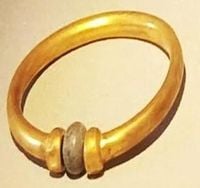Egypt is no stranger to the weight of history. Its ancient treasures have long inspired awe, pride, and a sense of collective identity among its people. But on September 9, 2025, that pride was dealt a devastating blow: a 3,000-year-old bracelet, once worn by Pharaoh Amenemope, was stolen from the Egyptian Museum in Cairo, then melted down for its gold, erasing a priceless piece of the country’s past.
The theft, which occurred in the museum’s restoration laboratory as staff prepared artifacts for an exhibition in Italy, was only disclosed publicly by Tourism and Antiquities Minister Sherif Fathy on September 20. The delay in announcement, coupled with the shocking details of the crime, unleashed a wave of anger and disbelief across Egypt. As reported by the Associated Press, Fathy did not mince words: “laxity” in security procedures was to blame, and the restoration lab where the bracelet was kept had no security cameras—a fact that has since provoked fierce criticism of museum oversight.
The bracelet itself was no ordinary trinket. Described by the Ministry of Tourism and Antiquities as “a gold band with a spherical lapis lazuli bead,” it belonged to Amenemope, a pharaoh who ruled Egypt from Tanis in the Nile Delta during the 21st Dynasty, around 993 to 984 B.C.E. Unlike some of his predecessors, Amenemope was not known for grand monuments, but he was celebrated for his steady leadership during a tumultuous era. The bracelet, unearthed from his tomb in the Tanis necropolis by French archaeologist Pierre Montet in 1940, was a tangible link to this ancient ruler and the world he inhabited.
The story of the bracelet’s disappearance reads like a tragic detective novel. According to All That’s Interesting, the theft was discovered as museum officials itemized artifacts ahead of their shipment to Rome. Within days, investigators identified the culprit: a restoration specialist at the museum. She confessed to passing the bracelet to an acquaintance who owned a silver shop in Cairo’s Sayyeda Zainab district. The silver shop owner then sold the artifact to a gold workshop for about $3,800, and it ultimately ended up with a smelter for roughly $4,000. There, the 3,000-year-old relic was melted down, its gold destined for new, far less significant jewelry. The lapis lazuli bead, once symbolizing the gods’ hair to ancient Egyptians, was lost along with the bracelet’s story.
Authorities moved swiftly. Four suspects were arrested and questioned, with confessions obtained from all involved. The Ministry of Tourism and Antiquities released security camera footage showing the bracelet being weighed and paid for in one of the shops, further sealing the case. The restoration specialist and the silver shop owner remain in detention, facing possible life imprisonment and fines up to $100,000, while the two other suspects may be released on bail of 10,000 Egyptian pounds (about $207) each, according to Associated Press reports.
The outcry from the Egyptian public and cultural leaders has been intense. Monica Hanna, dean at the Arab Academy for Science, Technology & Maritime Transport and a prominent campaigner for the return of Egyptian artifacts, called for a suspension of overseas exhibits “until better control” is established to secure the nation’s treasures. Human rights lawyer Malek Adly labeled the theft “an alarm bell” for the government, urging immediate improvements to security for both displayed and stored antiquities.
For many, the loss is deeply personal. Egypt’s ancient heritage is not merely a source of tourist revenue—it is a cornerstone of national identity. The theft has revived painful memories of past cultural losses, such as the disappearance of Vincent van Gogh’s “Poppy Flowers” from another Cairo museum in 2010, a painting that remains missing to this day. As Associated Press noted, the destruction of Amenemope’s bracelet is seen as one of the most serious breaches in recent years, given the rarity and significance of the artifact.
According to All That’s Interesting, the Tanis necropolis, where the bracelet was originally discovered, contains around 2,500 ancient artifacts, including golden funerary masks, silver coffins, and other treasures. The collection was restored in 2021 with help from the Louvre Museum in Paris, a testament to Egypt’s ongoing efforts to preserve its past. Yet the theft has exposed vulnerabilities that many fear could be exploited again if urgent reforms are not enacted.
The significance of the bracelet extended far beyond its material value. In ancient Egypt, gold was believed to represent the flesh of the gods, while lapis lazuli symbolized divine hair. The bracelet was not just jewelry—it was a sacred object, a piece of Amenemope’s story, and a fragment of humanity’s shared heritage. Its destruction means that historians and archaeologists have lost a unique window into the life and times of a pharaoh who, though not as famous as Tutankhamun or Ramses II, played a vital role in Egypt’s long saga.
The incident has also sparked renewed debate about the security of Egypt’s museums and the fate of artifacts displayed abroad. While some, like Monica Hanna, advocate for halting overseas exhibitions until better controls are in place, others point to the need for systemic reforms at home. The absence of security cameras in the restoration lab, as highlighted by Minister Fathy, is emblematic of broader issues that must be addressed if Egypt is to safeguard its treasures for future generations.
The investigation into the theft is ongoing, with the Interior Ministry signaling that more arrests may follow. In the meantime, Egyptians are left to mourn a loss that is, in many ways, immeasurable. As the dust settles, the theft of Amenemope’s bracelet serves as both a tragedy and a call to action—a stark reminder that history, once lost, cannot be remade.
The destruction of the pharaoh’s bracelet is more than a criminal act; it is a wound in Egypt’s cultural memory, one that will not soon heal. For a nation defined by its past, the imperative to protect what remains has never felt more urgent.






